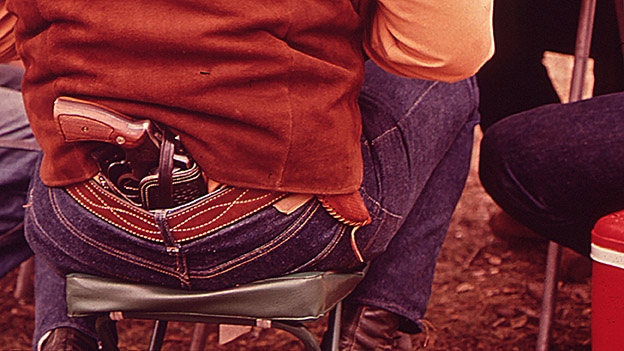The Glaring Lack of Science on Guns
It wasn’t the kind of legacy he was hoping for, but Frederick Rivera, a professor of epidemiology at the University of Washington, has had an outsized influence on our understanding — or lack of it — on guns and their impacts on public health.
In 1993, The New England Journal of Medicine published a study, co-authored by Rivera, assessing the risks of keeping a gun at home. The study, “Gun ownership as a risk factor for homicide in the home,” examined a set of 388 homicides that happened in the home of the victim. After controlling for drug use, prior arrests and domestic violence, the study’s authors came to a straightforward conclusion: Keeping a gun at home was “strongly and independently associated with an increased risk of homicide.”

The federal government supports research into traffic fatalities. But the purse strings are held tight for research into gun violence. Visual: Flickr
The research had been funded, in part, with federal money from the National Center for Injury Prevention, a division of the Centers for Disease Control. But the National Rifle Association, the gun industry’s powerful lobby, viewed the paper as little more than a piece of propaganda — a study designed to garner support for gun control.
Three years after the study’s release, after fierce lobbying from the NRA, former U.S. Rep. Jay Dickey, a Republican from Arkansas, introduced an amendment specifying that “none of the funds made available for injury prevention and control at the Centers for Disease Control and Prevention may be used to advocate or promote gun control.” In case the CDC didn’t get the message, Congress also reallocated $2.6 million — the amount invested in firearms research at the time — from the agency’s budget.
Two years later, Congress extended the same language to the budget of the National Institutes of Health.
The rule clearly didn’t ban gun research outright, but it did politicize and complicate the process for determining what research could and could not be funded, gumming up the gun-research pipeline enough that Rivera — and surely other scientists over the subsequent two decades — sought out new, less contentious areas of study where financial support would be forthcoming. “After the Dickey amendment, I really stopped gun research,” Rivera told me, adding that he shifted his focus to traumatic brain injury and accident prevention, where it was considerably easier to find grants and other support for basic science.
“People who are starting new research careers are going to be looking at what it means to be successful,” he says. “Clearly being successful is finding ways to fund your research.”
The stifling effects of the amendment have been dramatic. According to a report by Mayors Against Illegal Guns, a gun control group founded by former New York City mayor Michael Bloomberg, the CDC’s funding for firearm research has shrunk by 96 percent — to just $100,000 per year. And any researchers seeking to lay hands on the slim funds that are available face an uncomfortable relationship with the NRA. In 2011, the New York Times reported that the CDC was asking researchers for a “heads-up” for any research that touched on firearms, so they could alert the NRA ahead of time.
The result is that while the United States has the highest homicide rate in the developed world, researchers have very little empirical knowledge of the circumstances surrounding guns and violence — the sort of information that could point the way toward improvements and reform.
Rivera, for example, likes to compare guns to car accidents. Over the last century, the federal government directed substantial amounts of research funding into the study of fatal car accidents, and data on traffic accidents has been made publicly available to scholars for years. The research arising from all this has, Rivera notes, has helped to drive significant regulatory and safety improvements: First car registrations and licenses for drivers, followed by better speed limits and safer vehicles, and more recently, required gear like airbags and seat belts. As a result, deaths from car accidents have dropped dramatically.
In contrast, data on gun deaths is not publicly available and research on gun violence is slim. This means that all of the empirical insights that might lead to fewer gun-related deaths — how gun licensing affects safety, for example, or the relationship between illegal gun ownership and violence, or even how to manufacturer safer guns — effectively remain a mystery.
“So the gun violence epidemic in America really continues,” says Rivera.
What little research there is on firearms since the 1997 amendment has often come from researchers in other fields. Epidemiological disease modelers at Arizona State University recently completed a study on contagion in mass shootings, for example, but only with the help of student volunteers, and by pursuing the research on the side.
“The students that we get to work on it are basically working for free,” says Sherry Towers, a professor of mathematical modeling at ASU and one of the study’s authors.
Meanwhile, cities and states are attempting to fill in where federal research support falls short.
Just after the Newtown shooting in 2012, the city of Seattle allocated funds for an injury prevention research center, where Rivera is now researching injury recidivism in gunshot victims. California lawmakers are considering a similar bill.
Recently, President Barack Obama implored Congress to “end the freeze on gun violence research,” and even Dickey has said he regrets his amendment, apologizing for the knowledge gap that now exists.
Nevertheless, Congress has not reinstated the CDC’s gun research budget and according to Rivera, federal action will be necessary to make any real progress.
“It’s going to take a lot more than piecemeal funding to fill in our understanding of gun violence,” he says.











Comments are automatically closed one year after article publication. Archived comments are below.
I’m always amazed about how quickly “gun rights” trolls find any article on the relationship of guns with violence, and attack it with the usual NRA talking points. Must be someone’s full-time job or obsession.
Thanks, media, for taking time out of your busy schedule putting up the almost weekly ‘science’ cranked out the Bloomberg School of Public Health as unbiased ‘new findings’…to tell us that there is a ‘glaring lack of science on guns’.
You’re right, but not for the reasons you think you’re right.
I noticed that the counter claims to this article all fall along the lines of “it’s a conspiracy by the libruls” then blame “the illegals” or “well since there are other kinds of murder we don’t need to study murders with guns”
but in reality, it all comes down to this
1) the math hurts my feelings
2) I don’t have an actual counter-argument
3) therefore the math is wrong
4) ignore it or cry conspiracy
What a crock. Rivera stopped posting when John Lott Phd and others deconstructed the entire methodology of this bogus study.
The academics targeting guns have immense sources of left winger rich guys who routinely finance their shenanigans: Soros, Bloomberg, Buffet, Spielberg, etc. Perhaps the lack of published research is more due to the likely fact that they have done the research, and the data DOESN’T support their ideology.
or perhaps that’s the story you need to tell yourself because the reality hurts you feelings?
Pass mandatory criminal control!
Step one.
If charged with having/using a firearm unlawfully….
No reduced bail, Subject to an automatic dangerousness hearing, No plea bargains, No reduced sentences, No early release from prison, and minimum state sentencing laws for assaults and/or robberies committed with a firearm.
No need for step two.
‘Keeping a gun at home was “strongly and independently associated with an increased risk of homicide.”’ *yawn* Sure, if people in the home are homicidal. Otherwise, no.
Not taking sides but….
The author assumes that this is a Public Health imperative, Congress has decided that it’s a political issue. We don’t spend taxpayer money funding things the taxpayers (as represented by Congress) don’t want to pay for.
How is this wrong? Want the research done? Find the funding. Don’t send me a bill.
Were there no older studies available that would fit your agenda?
Didn’t take long to delete the conservative comment, the only one here.
Gun violence schmun violence. This is 23-year-old data. During that time, the population has grown by 60 million, many of whom are violent criminals and murderers. The claim that, “…the United States has the highest homicide rate in the developed world…” is a brazen lie. The subject “scientists” need to start dealing with the real problem — not gun murders — just murders. For example, of 218 nations measured, the U.S. ranks 98th, about in the middle. Stated another way, your chances of being murdered in the U.S. are 38 thousandths of a percent (.000038). In the U.K., your chances are one thousandth of a percent (.00001). That’s a difference of 28 thousandths of a percent, a very small difference any way you look at it. A politician’s trick perhaps.
The bottom line is we’re safer today than at any other time in our lives in spite of international terrorism. Seems all the howling over gun-this or gun-that is an old fashioned flimflam. When considering nations with murder rates lower than the U.S, one must consider the large number of murders by illegal aliens, 5,639 annually in the U.S., a higher proportion than in any other nation on earth – for now. That’s almost half the total intentional homicides in the U.S. Survival being what it is, at some point, every successful nation will have to face the violent people who want what they have.